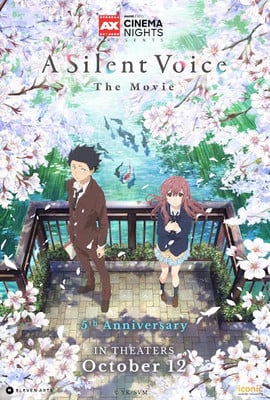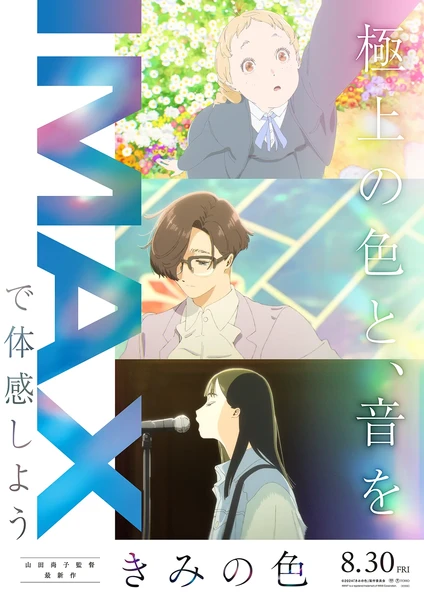Making The Colors Within: An Interview With Director Naoko Yamada and Composer Kensuke Ushio
by Andrew Osmond,
An original story created by Yamada and her regular scriptwriter Reiko Yoshida, The Colors Within is told mainly through the eyes of Totsuko Higurashi, a dreamy girl at a Catholic high school in present-day Nagasaki. Totsuko has the ability to see the inner colors of the people around her, and she's strongly drawn to another girl at her school, Kimi Sakunaga, who has an especially beautiful color. When Kimi stops coming to school, Totsuko tracks her down to a small bookshop, where she also meets a shy boy, Rui Kagehira. Somehow, all three youngsters end up practicing together as a band on a nearby island, expressing their secrets and insecurities through the music they make.
Thanks to Anime Limited, I interviewed Yamada together with kensuke ushio, who will need little introduction. He composed for Yamada's A Silent Voice and Liz and the Blue Bird and he's all over anime at the moment. In addition to The Colors Within, he's providing the music for the very different Science SARU anime DAN DA DAN and the series Orb: On the Movements of the Earth. Or maybe you know him for his Chainsaw Man music?
You started with some keywords and phrases you gave Reiko Yoshida to develop into a script. Can you talk about the ideas you began with and whether the three main characters were fully developed from the start?
Naoko Yamada: I think the three main characters came about as the scenario was being written. I started with the interior world of these characters, who are these kids who are really sensitive and who have various troubles and secrets that they can't reveal. They don't want to hurt the people around them, which makes them sensitive. That sensitive worldview is something that turned into Totsuko's feeling of colors, and then the fact that they can't put these things they feel into words turned into the idea of expressing [them] through music.
Much of the film takes place at a Catholic high school, which I guess will be an unfamiliar setting to most Japanese viewers and more familiar to some viewers outside Japan. Why did this setting appeal to you?
Yamada: You're right. It's set in a Catholic school, but I didn't set out to specifically make a film for Catholics. But I did think that people watching this film around the world, people familiar with Christian teachings, would get to see it, and that might help them to understand the film better. I thought it might give a framework to the film that helps people understand it without necessarily explaining everything in words.
Less than one percent of the Japanese population are Catholics, but there are a lot of other religions, Buddhism, Shinto… Most people would probably say they don't have a religion in Japan, but at the same time, you have people who believe different things, living side by side, going to the same schools and accepting and respecting one another. This, I think, says a lot about Japanese people's acceptance of difference.
So there are two things: the impression that the film would give to those watching in other countries and then the impression that Japanese people would get.

Two of your films have shown characters with unusual perceptions of the world. In The Colors Within, Totsuko perceives people's inner colors. In your previous film, A Silent Voice, the protagonist, Shoya, sees crosses blocking people's faces. Would you agree that Totsuko and Shoya have opposite kinds of perceptions?
Ushio: [in English]: That's a really interesting question! Do you know The Heike Story? [Naoko Yamada's historical series in 2021 for Science SARU, for which Ushio also composed]. The main character [the girl Biwa] sees the past and the future…
Yamada: I lost my train of thought…
Ushio: Sorry! (laughs)
Yamada: I never really connected them in that way, but now you mention it, I suppose they are opposite ways of seeing the world, in the sense that one is positive, and one is slightly more negative. Shoya is “hiding” people's faces, whereas Totsuko, when she's interested in someone, feels their colors. So the effect is opposite, I suppose, but they both have this way of sensing the world, that's something they have in common. So they are similar but at the same time opposite, as you said.
He thought it was a good question, so I thought I had to give a good answer!
Ushio: Sorry, my bad!
In one scene in The Colors Within, in which the girl characters are breaking the school rules, the music in the scene is a softened version of the Underworld track, “Born Slippy.” This may especially surprise British viewers, who may associate the track with the gritty depiction of drug addicts in the film Trainspotting. Did you have some kind of joke in mind in linking the song with a far more innocent situation, and was Ushio-san responsible for rearranging the track for your film?
Ushio: I actually don't know who came up with the idea of “Born Slippy” for this scene; it was a chicken-egg scenario. It's something from our teens, and when we were talking about what song should be playing on the scene, we came up with, “It should be sort of Born Slippy-ish,” in terms of the scene's meaning. In which case, why not just use “Born Slippy”?
So I stayed up all night, writing that version of “Born Slippy,” and I put it to the video, sent it to Yamada-san, and asked, “What do you think?” The reason for choosing “Born Slippy” for that scene is that we both felt that when we were teenagers, the worst thing we could possibly do would be set to the soundtrack of “Born Slippy.” The reason this is a soft version, as you say, is because however bad [the girls] think they're being in this scene, it's really cute and sweet, and what they think of as bad, the adults watching it will think, “Uh?” So this is their version of “Born Slippy.”
[in English] Her [Yamada's] reaction was so nice! She did not understand that this was a cover version. She thought it was a new track from Ushio, so her response was, this is actually similar to “Born Slippy” (laughs).

Ushio: All sorts, I guess… It's more the feeling, but I think maybe New Order, The Police as well, Talking Heads maybe… Probably New Order was the main one for me. We chose that music because that's our roots, not just New Wave.
Yamada: I also wanted the songs to be ones that these three teenagers could actually write and play. No complex chord progressions, but at the same time, they're making the coolest alternative band that they can. Not too many sounds, not too professional, commercial sounding…
Ushio: We thought about making a K-pop version, it might sell better!
Yamada: Ushio's a professional, but the hard thing was how far he could take it with the arrangements before they started sounding like a professional had written them. That balance was really important.
The design of Totsuko seems to be an extension of the design of the girl in your film Garden of Remembrance, with a “rounder” body than most girls in anime. [Yamada discussed this in a previous ANN interview.] You take the opportunity to show Totusko being very active, with beautiful images of her running and dancing. Are you finding it refreshing to use this round body type in your work?
Yamada: With Garden of Remembrance, one of the things I set out to do was to create a plumper female character and to show the appeal of that softness of that round body, the slight slackness of her daily life and the appeal of that. With Totsuko, she's going through puberty; it's a time when your body is going through so many changes both inside and out; you're not the final version of yourself yet. She's going through her second growth spurt, and I just thought a character like Totsuko, immature… It felt natural to draw her like this. Because all people aren't the same, and I felt like I was on a level with her as I was drawing her.
I also thought Totsuko had some very funny movements and facial expressions in the film. Do you think it is easier to create funny characters at Science SARU, given that the studio's animation often has a looser, more exaggerated animation style compared to Kyoto Animation?
Yamada: I don't think it's a case of the studio; it's what the film required. If I say this is the kind of freedom I need to create this film, then that would be possible at either studio.
discuss this in the forum (1 post) |